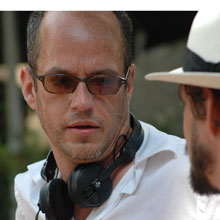Tom Kalin Interview On Directing 'Savage Grace,' Julianne Moore
Tom Kalin is the director of the art house classic Savage Grace, starring Julianne Moore, the psychologically disturbing film based on the gruesome murder of Barbara Daly Baekeland by her own son,and their incestuous relationship. The horror of the story is what grabbed Kalin's attention. “I was drawn to the scary challenge of this epic narrative,” he told Uinterview exclusively. “The world of these characters collides elegance and violence.”
Kalin, a noted director, producer and screen writer, is also a professor of experimental film at the European Graduate School in Switzerland. His films have focused on gay issues and AIDS, and he is considered a leader of the New Queer Cinema movement. Previous projects by Kalin include his debut independent film Swoon in 1992.
For Savage Grace, Kalin tried to find the human side of his characters despite their monstrous acts. “We were all more interested in showing these characters as humans,” he told Uinterview. “Deeply flawed, but human.”
1 Comments
Leave a comment
My producer Christine Vachon and I discovered early in our friendship that we shared an unhealthy appetite for true crime writing. She gave me the book Savage Grace in the early 1990s and I was mesmerized. It’s a sprawling oral history that covers nearly a century–I was drawn to the scary challenge of this epic narrative. The Baekeland saga is a uniquely American tale, with a vivid cast of characters and echoes of both Greek tragedy and classic literature like Henry James, Edith Wharton, F. Scott Fitzgerald or Patricia Highsmith. The world of these characters collides elegance and violence. It’s also a shocking story that has potential for over-the-top tabloid melodrama, but we were all more interested in showing these characters as human. Deeply flawed, but human.
It’s a cliché to say actors are brave when they play “difficult roles.” The truth is that adventurous, imaginative actors are drawn to high-wire challenges. Julianne [Moore], Eddie Redmayne and Stephen Dillane, along with the entire cast said yes to the roles and as far as I could tell, never looked back. I suppose their real bravery comes from the originality of mind not to judge these people, to try to bring empathy and compassion. Orson Welles once said: “Judge not lest ye bore the audience.” He was right. Of course, some of the moments were quite intense or uncomfortable to shoot, particularly the sequence in London between Barbara and Tony at the end of the film. But for every tense moment, many others were surprisingly light hearted; there was a fair amount of high-spirited giggling during the Paris hotel scene with Barbara and Brooks. It’s been said that film is a medium of “show not tell;” what’s important is to find the truth of the moment, what lays below the surface. This truth often resides in very small bits of behavior. I was inspired by something Elia Kazan wrote in his notebooks while preparing for A Streetcar Named Desire: "...directing finally consists of turning Psychology into Behavior."
Julianne is amazing; it was a gift to work together. She’s incredibly instinctive and watching her variety and subtlety from take to take is like watching a great musician. It took awhile to get the film together financially and logistically, so we had time to talk beforehand. She, of course, read the book, and I gave her many letters that the real Barbara had both written and received. Some of these mundane things were really useful to hint at the feeling of her daily life. We also had many photos of the family and I often used them to shape scenes. All the key actors strongly resemble the characters they play and that added a kind of eerie magic. Julianne and I also met a number of people who knew Barbara, separately and together. On set, we had to move fast, so it was great to have that basis of trust and knowledge of the material. Julianne is fond of Flaubert’s maxim: “Be regular and orderly in your life … so you can be violent and original in your work”. In interviews, she’s been quite clear about the difference between empathy and identification. She’s able to play these devastating roles but does not have to become them; because she does it so honestly people often think she must identify with the characters she plays. Maybe some times, but Barbara? I don’t think so. Julianne brought compassionate humanity, and this makes the performance unforgettable and true.
The same way I approach every scene. I ask myself what is literally happening–the physical action–what is happening underneath–the dramatic action–and how can I show the gap between the two. Sex is just another way we communicate with each other. It’s behavior. So I think the key is to try to reveal subtext, hint at what is underneath, and not just focus on the titillation factor. Many of us are still quite uncomfortable watching sex on screen–that makes for a very delicate challenge.
Well, I’m completely honored by the comparison. Of course, I was drawing on a really rich cinematic history when making the movie. Since the action spans 1946 to 1972, it seemed important to communicate period not just by production and costume design or hair and make up, but also by the photographic style, the way the camera relates to the characters. So in 1946, the camera only moves the way it would in that period and movies like Gilda, with Rita Hayworth, were useful. By the time we are in the late '50s or '60s, filmmakers like Bunuel, Godard, Losey, Bresson or Visconti created films that shifted the form itself, the way the story was told. Just like some painters or writers draw on, or reject, a tradition that precedes them, I think it’s rewarding to be in conversation with work that’s come before. Many movies echo other movies–but I hope I was able to draw on these influences in an authentic way. I don’t see my work as particularly “post-modernist,” whatever that is; it’s not about cut and paste collage or parody. I was surprised when some people thought the movie was intended as camp melodrama–the performances completely contradict that I think.
I’ve had an eclectic career that reflects the fact that I started as a painter, than wandered into photography, installation and video art before making feature films. For the past 20 years, I’ve made a body of short work in super 8 and video that has been broadcast on television and showed in galleries and festivals. This work is available in the US at Electronic Arts Intermix, the Video Data Bank and V Tape in Canada. Between Swoon and Savage Grace, I developed two "non fiction" features–one about the relationship between Patti Smith and Robert Mapplethorpe and the other about an American rock band in Germany called The Monks. I wrote scripts for both but never shot them. I produced I Shot Andy Warhol and Go Fish and was a co-Writer of Office Killer. I did a short with Frances McDormand and Lili Taylor that was on PBS in the late 1990s. I made a silent film for designer Geoffrey Beene’s 30th anniversary with Viveca Lindfors, Marcia Gay Harden and Claire Danes. That was a great treat, one of the most fun and inspiring things in my life was to collaborate with him–Geoffrey Beene was brlliant!
The autobiographical answer is that my father spent his entire career working in social work and criminal justice fields. He was the director of a reformatory school called the Saint Charles School for Boys and later worked for the National Council on Crime and Delinquency. At the end of his career he worked for the State of Illinois Parole Department, which includes Stateville Penitentiary where Leopold and Loeb were imprisoned. As a teenager I visited the prison several times. I am the youngest of 11 children and had quite a lively childhood to say the least. The Leopold and Loeb case was famous in Chicago where I grew up and my parents were children in the early 1920s, so it loomed large as folklore. Having parents who grew up in the Depression made that early time seem close, present. I also read Capote’s In Cold Blood when I was very young and was very captured by it, the balance between fact and the modes of novelistic storytelling.
Of course, there are parallels–and differences–between Swoon and Savage Grace. Both stories involve symbiotic characters; in the mythical sense almost two halves of one whole. Swoon is a much more “romantic” movie, if that’s the right way to put it, influenced in part by couples-on-the-run films like Badlands or Bonnie and Clyde. Clearly, both movies feature characters trapped in an erotic and fatal dance. Swoon is more “didactic” and symbolic, I think; Savage Grace lacks that sort of impetus. I really just wanted to tell the particular story of the Baekeland family as honestly as I could. It’s not a “message movie.”
I have spent most of the summer upstate New York in my house in the Catskills. It’s been heaven, but I have only watched DVDs and am completely out of the current movie loop. Here’s a few favorites, none of them brand new: Ball Of Fire, Three On a Match, Night Nurse, There Will Be Blood, Days of Heaven, Thief Of Bagdad, The Furies, Who Are You, Polly Maggoo?, Holy Girl Playtime and The Sweet Smell of Success.
A new short video/installation called Cheap & Vulgar. And I am just starting to write a feature script set in the early 1930s. I’m also pursuing rights to a novel. Fingers crossed!
RELATED ARTICLES
Get the most-revealing celebrity conversations with the uInterview podcast!






Julianne Moore was amazing in that movie!